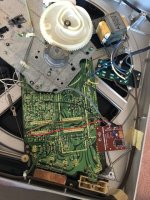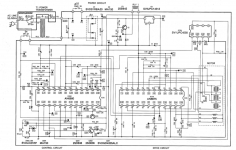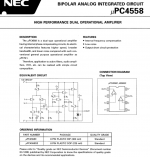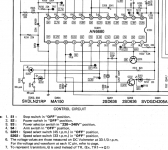While working on a Technics SL-Q2, I noticed on the schematic I'm missing a smaller PCB containing the uPC4558 IC.
Can anybody explain why this chip is there? The turntable seems to work just excellent without it.
While looking through the datasheet of this uPC4558 it is described as an amplifier, with a RIAA schematic as example but it is definitely not used for this with the SL-Q2. Also it looks like a hack or mod, though it is shown as original in the schematic.
It also makes me wonder if this would be beneficial for other Technics
The photo attached is from the 1 G**gle hit I got searching for this.
Any insight would be very much appreciated
Can anybody explain why this chip is there? The turntable seems to work just excellent without it.
While looking through the datasheet of this uPC4558 it is described as an amplifier, with a RIAA schematic as example but it is definitely not used for this with the SL-Q2. Also it looks like a hack or mod, though it is shown as original in the schematic.
It also makes me wonder if this would be beneficial for other Technics
The photo attached is from the 1 G**gle hit I got searching for this.
Any insight would be very much appreciated
Attachments
Last edited:
Without that amplifier, there is no feed back and the speed will vary with power supply changes.
Ah I see now. :lightbulb: It's a generator coil.
But if my regulated PSU is spot on, this wouldn't be needed right?
Hi,
the OPAmp is used to condition the signal from the frequency generator, "FG" coil, connected to pins 2 and 3 of the OPAmp.
The FG coil is the meandering coil positioned radially around the motor core and connects to the PCB via two short wires.
In case of loosing FG-signal the platter speeds up.
Then check the solder joints of the two wires on tiny cracks and resolder if neccessary.
jauu
Calvin
the OPAmp is used to condition the signal from the frequency generator, "FG" coil, connected to pins 2 and 3 of the OPAmp.
The FG coil is the meandering coil positioned radially around the motor core and connects to the PCB via two short wires.
In case of loosing FG-signal the platter speeds up.
Then check the solder joints of the two wires on tiny cracks and resolder if neccessary.
jauu
Calvin
The processor requires feedback to keep the frequency generator running at the correct speed. If it gets no pulse from the FG coil, it will tell the processor that the motor is running too slow or indeed stopped and increase the frequency. If the speed is set without the FG pulse as the power voltage varies, the oscillator will vary.
In other words, it keeps the motor speed stable.
In other words, it keeps the motor speed stable.
Thanks for your clarifying answers!
But while inspecting the PCB today, it looks like this turntable never had the "extra" PCB. Also it runs spot on that's why I asked.
Anyways I ordered an original OPAmp to try and see if I can measure some difference. It has to come from Japan though so that will take a few weeks...
But while inspecting the PCB today, it looks like this turntable never had the "extra" PCB. Also it runs spot on that's why I asked.
Anyways I ordered an original OPAmp to try and see if I can measure some difference. It has to come from Japan though so that will take a few weeks...
You don't need original 4558 from Japan. 4558 is standard industrial grade opamp produced by many factories and is available from any electronics parts shop. Also, you can use some even better opamp for the same purpose.
You don't need original 4558 from Japan. 4558 is standard industrial grade opamp produced by many factories and is available from any electronics parts shop. Also, you can use some even better opamp for the same purpose.
Yeah I figured, but there are no local part stores here. So ordering from overseas with free shipment is a lot cheaper... and it's an original parts so thats nice. But about your suggestion, what would be a better opamp? and would there be any benefits of using a better one?
May be it's some later revision of PCB where 4558 is on the big PCB.
Nope, really not there...
For instance NE5532 would be better opamp. There will probably be no great benefits but I thought that the price difference is negligible so why not using better part if it is easy to find in any shop and is cheap.
Compare markings on the big ICs on the big PCB and the schematic. May be that at some later date Technics used different dedicated ones that had opamp inside them so that there was no need to use external opamp.
Compare markings on the big ICs on the big PCB and the schematic. May be that at some later date Technics used different dedicated ones that had opamp inside them so that there was no need to use external opamp.
Found it, Q203 is not mentioned in the service manual I found, but it is on the PCB. Transitor C1328. After another search I found the same transistor used for the FG coil on the SL1200 MK2 board...
So I guess you're right and I don't need the extra board because it's already on the main PCB.
You don't need original 4558 from Japan. 4558 is standard industrial grade opamp produced by many factories and is available from any electronics parts shop. Also, you can use some even better opamp for the same purpose.
No need for any "better" dual opamp for this service!
Best regards!
I can't imagine any original design being released with an add-on board like that. It is possible that your TT is an early revision, one before the board was added at a later revision.
I have same deck and I thought I had lost this pcb as mine will only play at 33
As far as I know the speed control on the SL-Q2 is done by the AN6680 on pin 7(33rpm) & 6(45rpm). The IC mentioned at the start of this topic is (as said) used to correct the speed if it is not 33 or 45.
Attachments
Hi,
the voltage levels Pins 6 and 7, defined by the switches S201 and 202, select the speed. The 'control' is due to the signal genetated by the FG coil, conditioned by the OPAmp and fed back via R203 to the AN6680.
jauu
Calvin
the voltage levels Pins 6 and 7, defined by the switches S201 and 202, select the speed. The 'control' is due to the signal genetated by the FG coil, conditioned by the OPAmp and fed back via R203 to the AN6680.
jauu
Calvin
- Status
- Not open for further replies.
- Home
- Source & Line
- Analogue Source
- Technics SL-Q2 what is the SV1UPC4558 for?




